More on the Octavien Brothers
© Martin Eidelberg
Created December 2022
© Martin Eidelberg
Created December 2022
Although obscure until recently, the paintings and drawings of the two Octavien brothers are finally coming into focus and even into the limelight. As Guillaume Glorieux has demonstrated, there were two brothers, both named François, who although born in Rome, established their careers in France in the second quarter of the eighteenth century.1 François the Elder, born in Rome c. 1682, settled in Paris where he married in 1712. He was apparently active as a singer before he turned his attention to painting, and was admitted to the Académie royale de peinture et de sculpture in 1725. His younger brother was also born in Italy, though the year of birth is unknown. He too traveled to France and settled in Paris, but unlike his brother, he did not join the Académie. While both brothers painted in the same years, they supposedly worked independently of each other—although that supposition may not be entirely correct. The younger artist died in 1732 in Paris, whereas the older died in 1740, by which time he had moved to Versailles.
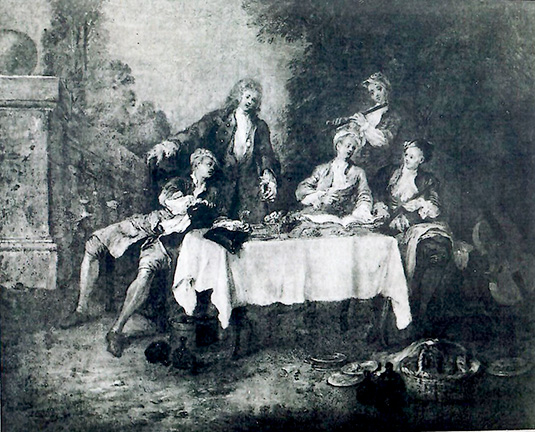 |
1. François Octavien, Luncheon Party, oil on canvas, 33 x 41 cm. Whereabouts unknown. |
One of the prime pictures attributed to François the Elder is an outdoor scene of five men around a table, the meal now concluded but a tablecloth is still in place and debris from the repast lies scattered in the foreground. A flutist plays and some of the men sing. It is a banqueting scene of a type painted by Lancret, Oudry, and many others. When the picture was published by Jean Messelet in 1928, it was then in the collection of Maurice Roquigny, who noted that it was signed.2
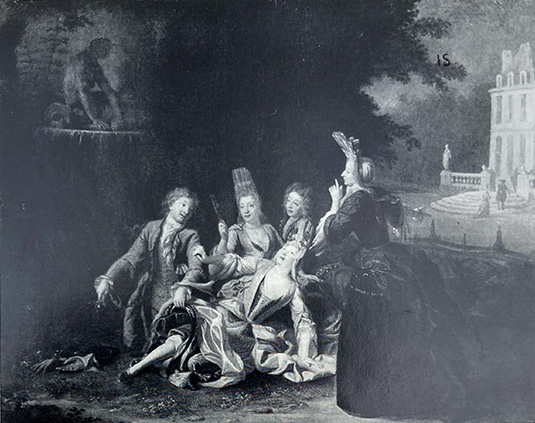 |
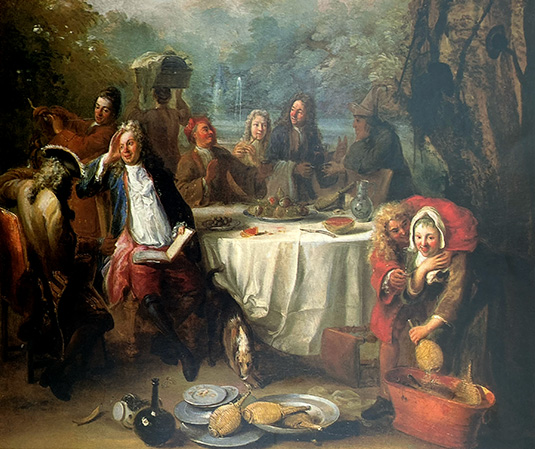 |
2. Unidentified French artist, Scène galante, Nantes, Musée des beaux-arts. |
3. Jacques Autreau, Banquet Scene, Whereabouts unknown |
It is a delightful work, but in many ways it is sweeter in mood and more accomplished than most paintings ascribed to François the Elder. The faces are more fully modeled, and richer and characterful. The flickering brushwork seems more painterly than customary. Perhaps these are the reasons that caused Guillaume Glorieux to reject the attribution. Instead, he assigned it and other luncheon scenes to an otherwise unidentified artist (figs. 2, 3). However, the three pictures he grouped together, while related thematically, show great stylistic differences between each other. The other two display stockier figures and a robust sense of narrative; they are tied to the late seventeenth and very early eighteenth century. One (fig. 2) resembles the work of Nicolas Bonnart (1637-1718), Claude Simpol (1666-1711), and other engravers of popular prints, while the other (fig. 3) has much in common with the many group portraits by Jacques Autreau (1657-1745). By contrast, the ex-Roquigny picture is clearly imbued with the aesthetic and style of the years between 1720 and 1750 in France. Although the painting has not been seen for almost a century, its signature may well be genuine.
 |
4. Thevenard after François Octavien the Elder, Dame à sa toilette, engraving. |
An exciting insight into François the Elder’s domestic scenes is offered via a print by one of the Thevenard family of engravers (fig. 4).3 It depicts a lady of quality at her toilette, attended by a woman servant and being visited by an abbé or cleric. Unfortunately, the painting on which it was based has not survived. Similar pictures by Pater, Lancret, and others in the generation after Watteau suggest this new anecdotal genre was popular.
 |
5. François Octavien the Elder, Le Sommeil dangereux, oil on canvas, 73.5 x 92.7 cm. Whereabouts unknown. |
An equally exciting addition to the elder Octavien’s oeuvre is another domestic genre scene, one which is more explicitly amorous (fig. 5).4 It depicts a gentleman stealthily approaching a woman asleep on a sofa, his arm outstretched as he reaches forward to snatch the letter in her hand. Perhaps he hopes to discover the identity of another of her suitors. The tethered monkey in the foreground reminds us of human folly. When this painting was at auction in 2003, it was wrongly ascribed to the circle of Michel Berthelemy Ollivier (1712-1784) but a comparison with Octavien’s paintings, especially the one engraved by Thevenard (fig. 4), points instead to Octavien. In fact, it is quite probable that this picture should be identified with an Octavien painting that sold in London in 1830 and that was described as showing a gentleman cautiously approaching his sleeping mistress.5 In that early nineteenth-century catalogue the year 1726 was cited after the artist’s name, presumably because the painting was dated, perhaps even signed. Apparently that valuable information was no longer visible by 2003. Not least, there apparently was a Thevenard engraving after this composition. It was cited by Rey, but it has not been possible to locate an example of this rare print.6 Nonetheless, even without the visual evidence of the engraving, the attribution to Octavien is secured. Indeed, it seems likely that the two paintings engraved by Thevenard were pendants. They complement each other compositionally and thematically.
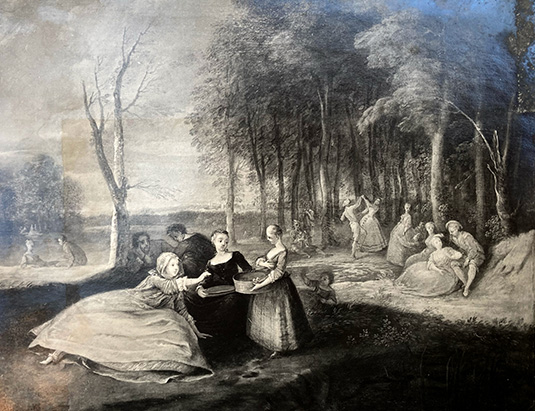 |
6. François Octavien the Younger, La Rejouissance dans le parc, oil on canvas, 62 x 79 cm. Whereabouts unknown. |
The oeuvres of both Octaviens are larger than had been realized, and still more works can now be recognized, especially those by François the Younger. Previously overlooked is an ambitious fête galante that came up at auction in 1932 (fig. 6).7 At that time, now almost a century ago, it was attributed to Jacques Sébastien Le Clerc, generally known as “Leclerc des Gobelins” (1733-1785). However, this picture has little relation to that Watteau satellite. Rather, it shares very specific traits with the many fêtes galantes by the Octavien brothers.
 |
7. François Octavien the Elder, Fête galante, oil on canvas, 77 x 109 cm. Whereabouts unknown. |
The expansive flat terrain, the arrangement of the group of figures in the foreground, the women’s faces, the couple dancing in the distance, even the inclusion of a dead tree—all these are the hallmarks of compositions by François Octavien the Elder (fig. 7).
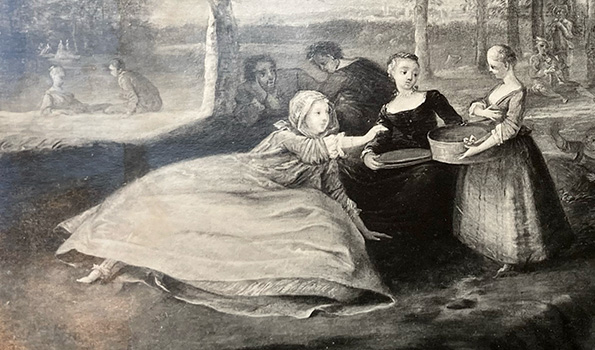 |
 |
8. François Octavien the Younger, La Rejouissance dans le parc (detail). |
9. François Octavien the Younger, Le Repos dans la campagne (detail) oil on canvas, 26.5 x 38 cm. Whereabouts unknown. |
Yet, the case is not all that simple. The women in the foreground exhibit a disturbing resemblance to the work of François the Younger. The simplistic modeling of the faces and the curious folds of the seated woman’s gown in horizontal striations match what we find in paintings by François the Younger, as in a pair of pendants published before (fig. 9). But if La Rejouissance dans le parc is by François the Younger, as now seems to be the case, what does that imply about the relationship between the two brothers? Until now it has been customary to presume that they worked independently of each other, but the example of La Rejouissance dans le parc suggests that the younger brother may have worked more closely under his brother’s influence, perhaps even in collaboration.
A very different and equally curious picture possibly painted by François the Elder is a genre scene in which a woman with a musette and a youth with a hurdy gurdy are posed behind an arched opening (fig. 10). This illusionistic format was popularized by Dutch artists such as Gerrit Dou (1613-1675) and Frans van Mieris (1635-1681) (fig. 11). When this picture came to auction in 1986 it was classified as “Attributed to François Octavien” and described as “signed(?).”8 Evidently there was an illegible signature or traces of one, perhaps on the foreground ledge. One may well wonder if this was not one of a pair of pictures sold in Paris in 1843:9 Each was signed, and one showed a woman playing a musette and the other portrayed a male violinist. Unhelpful, the 1843 catalogue classified the pictures simply as ”Octavien.”
The pairing of a musette or bagpipes with a hurdy-gurdy is an unusual musical combination. Equally noteworthy are the fanciful costumes. Are they theatrical or are they meant to be Oriental, perhaps Turkish? In any event, this simple picture, more enigmatic than might have been thought, suggests aspects of the artist’s work that we had not previously considered.
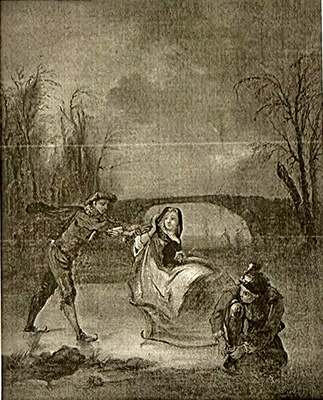 |
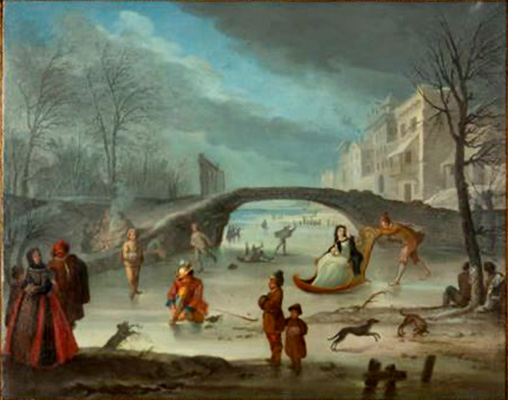 |
12. François Octavien the Younger, L’Hiver, oil on canvas, 40 x 32.3 cm. Whereabouts unknown. |
13. François Octavien the Younger, Winter Skating, oil on canvas, 72 x 90 cm. Whereabouts unknown. |
A number of works can be added to the oeuvre of François the Younger. The first is a scene of winter entertainment on a frozen pond (fig. 12).10 It traveled under Nicolas Lancret’s name in 1990, both at several exhibitions and when it was at auction. Even Mary Tavener Holmes authenticated it as an autograph work from Lancret’s hand. But, as should have been apparent, it bears no resemblance to Lancret’s paintings, neither in composition or execution, especially not the faces. As noted on a previous occasion, its subject can ultimately be traced to a composition by Antoine Pater. Even more directly, this painting derives from one by François Octavien (fig. 13). The young man pushing the woman in the sled, the youth crouching on the ice, securing his skates, even the bridge in the background—all these elements are reductions of elements from Octavien’s larger, more ambitous model.
Another wintry scene perhaps painted by François the Younger appeared at auction under an attribution to his older brother (fig. 14).11 Reoccuring here are the woman in the sled and the man pushing her, both as in the previously discussed Octavien pictures but, in fact, the entire composition is dependent on a Watteau drawing engraved in the Figures de différent caractères (fig. 15). The painting includes not only some of Watteau’s secondary figures but also the complex of buildings at the side. Interestingly, the picture accords with what would have been the direction of Watteau’s drawing; that drawing has not survived and is known only through the Jullienne engraving. If the painting is indeed by the younger Octavien, as seems to be the case, his access to such a valuable document may suggest something of the artist’s circle of artists and collectors.
There are several old records of paintings by “Octavien,” presumably but not necessarily signifying François the Elder.12 Relatively scarce in comparison with references to paintings by Pater, Lancret, and even Bonaventure de Bar. Found in eighteenth- and early nineteenth-century inventories, they are more trustworthy than not because they were written at a time when there would have been no monetary or other incentive to propose an attribution to Octavien if the paintig were not genuine. Two large paintings ascribed to Octavien, both showing hunters, appeared at the 1764 sale of the comte de Saint-Maure.13 Another--a scene of hunters at rest--figured in a Paris auction in 1778.14 The following year a painting described as showing country amusements was offered in a Paris auction.15 Occasional references to Octavien pictures can be found in mid-nineteenth century sales, in pre-Goncourt years. For example, a picture described as Délassments champêtres was presented for sale in 1858, and another called Danse de Villageoise appeared in 1870.16 Even if we cannot match these references with extant works, nonetheless, their subjects accord with the pictures that have been discussed here.
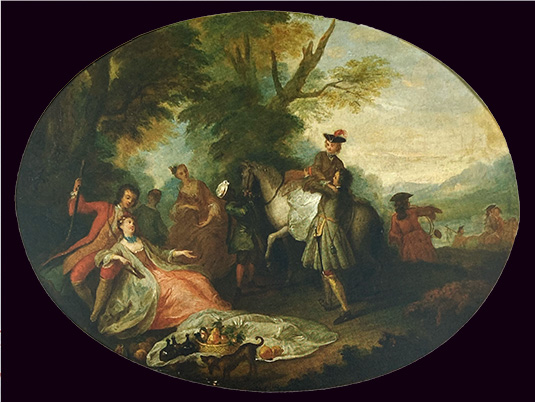 |
16. Here attributed to Sebastian Leclerc, A Hunt Picnic, oil on canvas, 53 x 69 cm. Whereabouts unknown. |
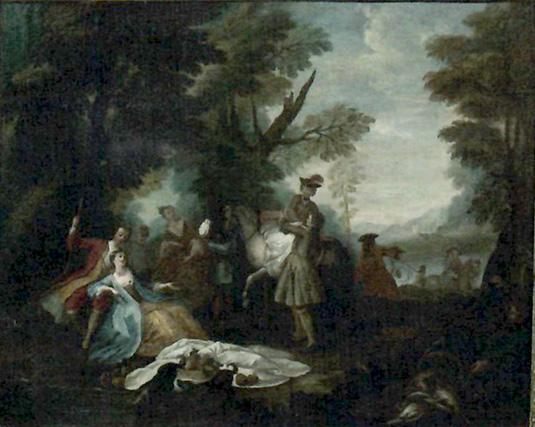 |
17. Here attributed to Sebastian Leclerc, A Hunt Picnic, oil on canvas, 63 x 80 cm. Whereabouts unknown. |
While we have increased the number of known paintings by these two brothers, a substantial body of works attributed to them should be suspect if not rejected. Two such pictures depict scenes of hunting parties stopping for a picnic lunch (figs. 16, 17).17 Both share the same composition, but one has an oval format and is slightly smaller, while the other is rectangular and larger. Hunt picnics were not an uncommon subject among painters of fêtes galantes. When these two hunt picnics appeared for sale, in 2006 and 2017 respectively, they were given to François Octavien, presumably François the Elder since at that time we were unaware that there he had a younger brother. However, the paintings are richer in composition, the figures are better drawn, their groupings more complex, and the landscape more verdant than in any of the known paintings by either of the Octavien brothers.
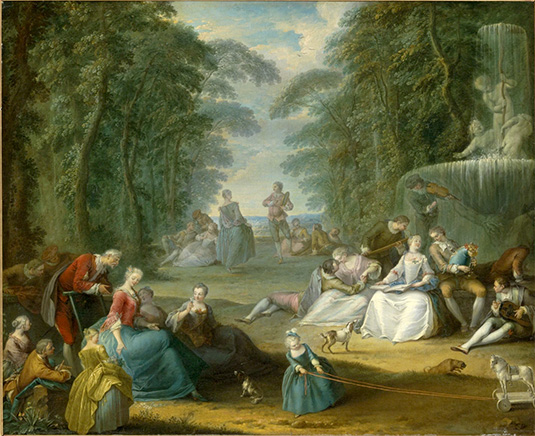 |
18. Jacques Sébastien Leclerc, Fête galante, 1749, oil on canvas, 64.5 x 78.9 cm. Whereabouts unknown. |
The two hunt lunches have much in common with paintings by Jacques Sébastien Leclerc (1733-1785), generally known as Leclerc des Gobelins. A fête galante by him, recently sold from the Elizabeth Stafford collection, though painted before the artist was even twenty years old, shows his accomplished manner (fig. 18). The relaxed postures and the rounded sense of form and smooth surface that we see here correspond to what we see in the two hunt picnics, sufficiently so that they can be re-attributed to him.
That a large number of paintings have wrongly been identified with François Octavien should not be surprising because this is the case with pictures by many of Watteau’s satellites. When attributions to Watteau cannot be sustained, and when an attribution to Pater or Lancret cannot be substituted, the names of still lesser followers are proposed. Accordingly, a great many, highly disparate works have been given to the Octaviens. The following examples suggest the range of paintings that have been and continue to be wrongly attributed to them.
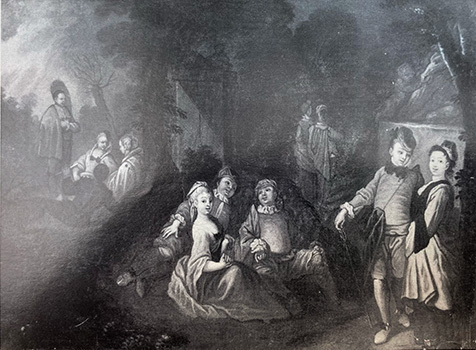 |
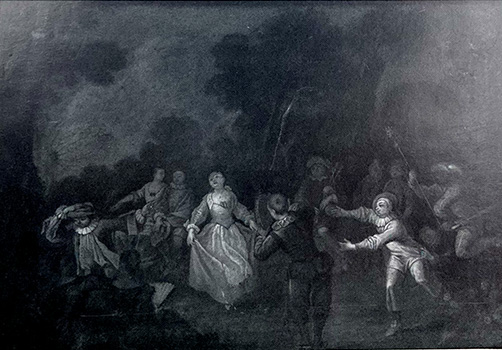 |
19. Anonymous French artist, Fête galante, oil on canvas, 45 x 62 cm. Whereabouts unknown. |
20. Anonymous French artist, Fête galante, oil on canvas, 45 x 62 cm. Whereabouts unknown. |
When two undistinguished fêtes galantes appeared on the art market in 1990 (figs. 19, 20), they were attributed to the “entourage of François Octavien."18 Yet they show no specific resemblance to works by him. Rather, they are just clumsy imitations of fêtes galantes by the young Watteau and his followers.
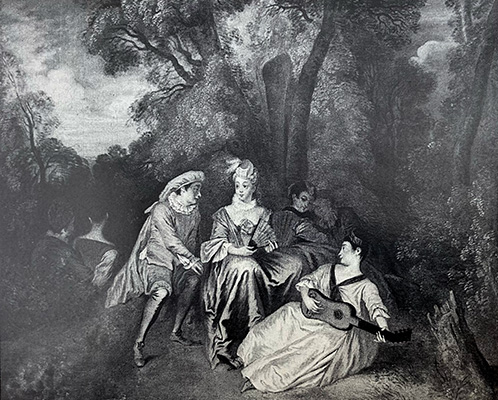 |
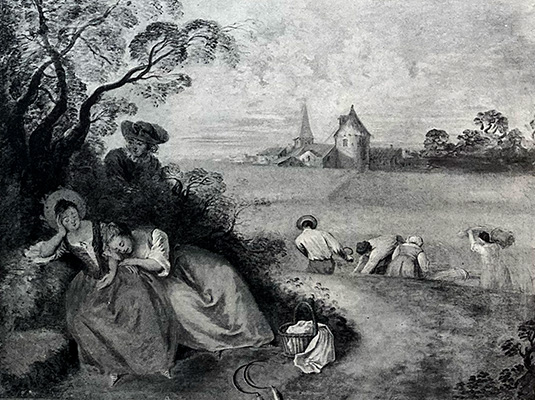 |
21. Unidentified artist, Scène galante, oil on canvas, 72 x 92 cm. Whereabouts unknown. |
22. Unidentified artist, Summer, oil on canvas, 72 x 92 cm. Whereabouts unknown. |
A pair of paintings presented in 1986 as “attribué à François Octavien” typify the art market’s deceptions (figs. 21, 22).19 First, they seem ill-suited as pendants. The scale of their figures and the formats of their landscapes do not correspond to each other. Although supposedly allegories of Autumn and Summer, subjects that might support the notion that they are pendants, the subjects need to be reconsidered. The picture showing two women asleep in the shade of a tree and the harvesting of wheat in the background conforms to traditional representations of Summer, but there is nothing in the image of the commedia dell’arte characters in the other painting to suggest Autumn or any other season.
 |
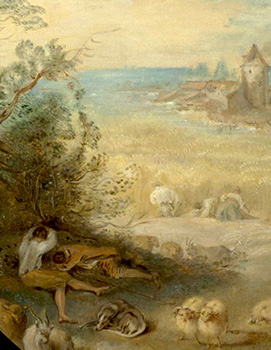 |
23. Pierre Chedel after Watteau, Harlequin jaloux, engraving. |
24. Jean-Baptiste Pater, Summer (detail), oil on canvas. Cleveland, Museum of Art. |
Not least is the issue of authorship. Faute de mieux, Octavien’s name was a flag of convenience under which the paintings were their floated, but there is nothing here to suggest Octavien’s hand. Essentially, the pictures are variations on compositions by Watteau and Pater. The scene with the commedia dell’arte figures was inspired by Watteau’s Harlequin Jaloux (fig. 23), while the second picture, Summer, is related to a Pater composition such as a scene of summer in Cleveland (fig. 24).
 |
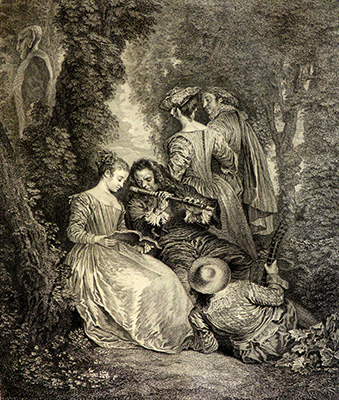 |
25. Unidentified artist after Watteau, L’Accord parfait, oil on canvas, 87.5 x 105 cm. Whereabouts unknown. |
26. Bernard Baron after Watteau, L’Accord parfait, engraving. |
A good example of how anonymous copies and variations after Watteau’s compositions continue to be attributed to Octavien and other Watteau satellites is a fête galante that appeared at a Paris auction in 1989 under Octavien’s name (fig. 25).20 No mention was made that it was a reshuffling of figures from the engraving after Watteau’s L’Accord parfait (fig. 26). A decade later the so-called Octavien twice came up in New York auctions, on these occasions attributed no more convincingly to Philippe Mercier; but, at least, it was recognized to be a variation on a composition by Watteau. All this is like a game of Russian roulette—with the hope that one of them will hit the proper mark.
When Une Élégante compagnie (fig. 27) came up at auction in 1996, it was given to the “entourage de François Octavien.”21 Yet the picture bears no relation to Octavien whatsoever. On the other hand, it is closely linked to works by Nicolas Lancret, such as his painting Dans cette aimable solitude in Cambridge (fig. 28).22 Both pictures feature a seated woman with a shawl over her head, a second woman and a young man standing behind her. That the so-called Octavien painting is in the reverse direction of the Cambridge painting suggests that the artist relied on the engraving after it by Charles Nicolas Cochin. However one choses to classify Une Élégante compagnie among the copies and imitations by Lancret’s many followers, there is no reason to associate it with either of the Octavien brothers.
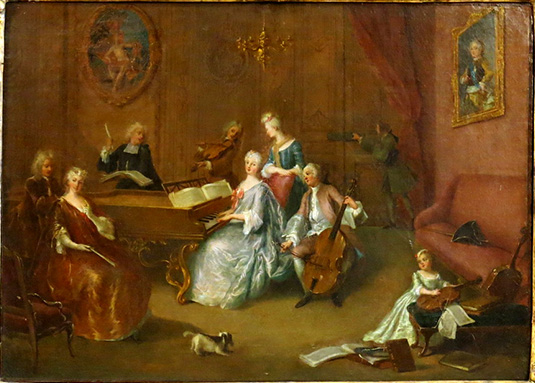 |
29. The Nantes Master, Une Réunion musicale dans un salon rococo, oil on canvas, 42 x 58 cm. |
An appealing genre scene of elegantly dressed people assembled in a fashionable salon, preparing to give a concert, has been attributed to Octavien (fig. 29).23 However, as I demonstrated on a previous occasion, it was executed by an otherwise anonymous French painter active in the middle third of the eighteenth century, and whom I named “the Nantes Master” in recognition of two of his paintings in that city’s museum.24 His delight in depicting a narrative and in rendering the details of the room and its furnishings are hallmarks of his art. Equally characteristic is his sense of composition, with the figures arranged in a frieze, leaving the upper part of the canvas relatively empty, and bracing the whole arrangement with the child and still life of musical instruments at the right and the seated woman at the left. Whatever his identity proves to be, his work is quite distinctive and different from Octavien’s. A comparison with Octavien’s Dame à sa toilette (fig. 4) reveals how exaggerated the Nantes Master’s proportions are, and how distracting is his concern with the details of the room’s accessories.
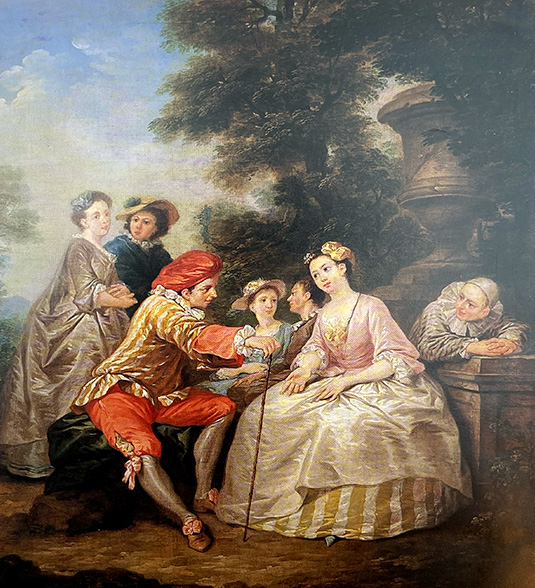 |
30. Unidentified French artist, Scène galante dans un parc, oil on canvas, 58 x 50 cm. Whereabouts unknown. |
A number of paintings with large-scale figures have been assigned to Octavien, although, as might be expected, there is essentially no reason to accept these attributions. For example, a scene galante featuring seven men and women in a garden has repeatedly appeared on the market since World War II, most recently in 2002, and always under Octavien’s name (fig. 30).25 Yet this picture bears no resemblance to Octavien’s accepted paintings. While it appears to be French and of the mid-eighteenth century, the awkward, maladroit figures mark the artist as less than fully skilled.
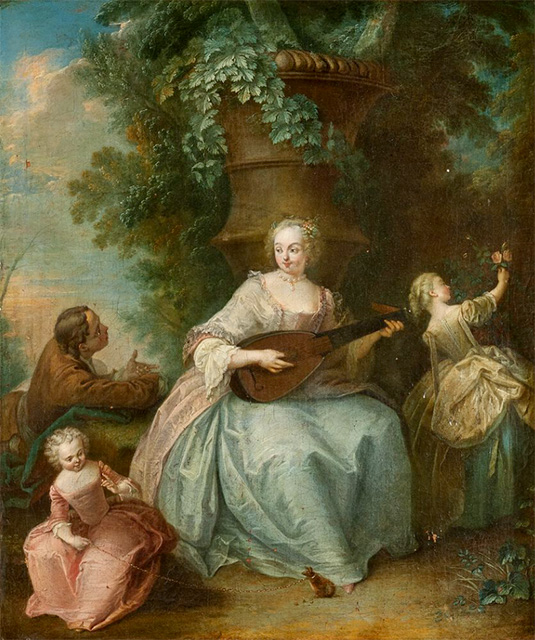 |
31. Unidentified French artist, Jeune femme jouant une mandoline, oil on canvas, 67.7 x 57.1 cm. Whereabouts unknown. |
Another but accomplished picture wrongly attributed to Octavien is one that appeared at a Paris auction in 2022 (fig. 31).26 Here again the question remains what is the rationale for giving it to Octavien the Elder; what justifies the attribution? Although an attractive picture, it lacks any visual relation to his known works. The inescapable conclusion is that the painting should be struck from his oeuvre.
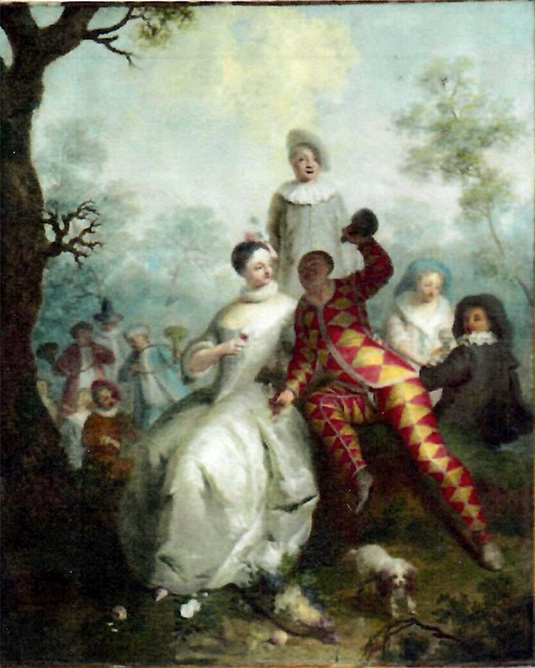 |
32. Unidentified French artist, Fête champêtre, oil on canvas, 94.9 x 95.9 cm. Whereabouts unknown. |
A painting of with equally monumental characters, but by a very different artist, has also wrongly been given to Octavien (fig. 32).27 Here too one wonders what resemblance there is between these elongated, mannered figures and those in Octavien’s established oeuvre. The general conception of an aggressive, rambunctious Harlequin plying his female companion with wine might recall Watteau’s Voulez-vous triompher des belles? Alongside similar scenes by Lancret and Watteau’s other satellites, this helps supply a context for this painting, but does nothing to justify its attribution to Octavien.
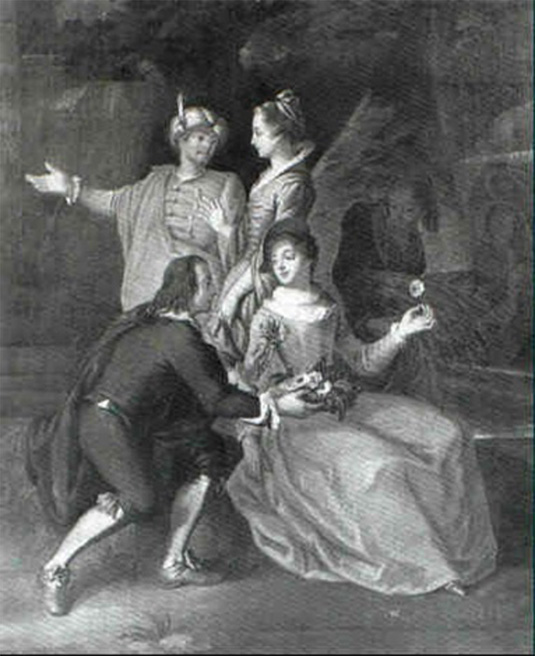 |
33. Anonymous artist, Scène galante dans un parc, oil on canvas, 128 x 108 cm. Whereabouts unknown. |
If the previous paintings were too slick to be by Octavien, then a comparable subject of theatrical characters seen at auction in 1994 is too unskilled to be by him (fig. 33).28 Except for the turbaned man (whose grand gesture resembles that of the actor in the foreground of Watteau’s La Perspective), the postures are wooden and awkward. That such different pictures—too suave or too gauche—could be ascribed to one artist suggests the vagaries of current connoisseurship.
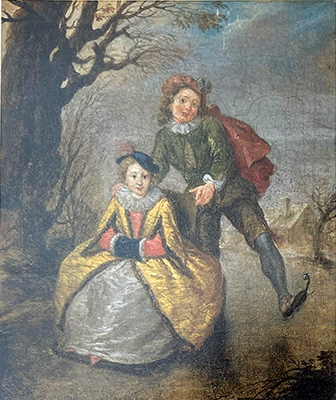 |
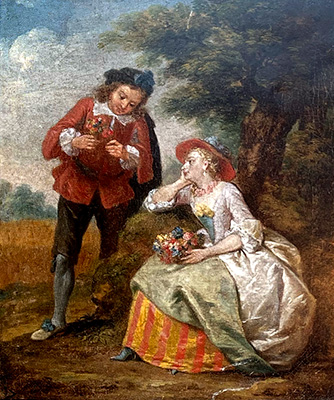 |
34. Unidentified French artist, Winter, oil on canvas, 41 x 33 cm. Whereabouts unknown. |
35. Unidentified French artist, Spring, oil on canvas, 41 x 33. Whereabouts unknown. |
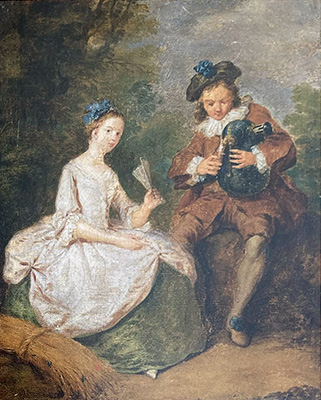 |
 |
36. Unidentified French artist, Summer, oil on canvas, 41 x 33. Whereabouts unknown. |
37. Unidentified French artist, Fall, oil on canvas, 41 x 33. Whereabouts unknown. |
Similarly and still without good reason, a series of Four Seasons has been given to François the Elder (figs. 34-37).29 Here again while the paintings are clearly by a French artists contemporary with Pater and Lancret, they show no tell-tale traits of Octavien’s art.
These false attributions are the constructs of auction houses and dealers in need of a name to make their anonymous paintings more attractive. The harm that they do is considerable because they confuse the true identity of François Octavien and his brother and encourage other false attributions. Indeed, the number of wrongly attributed works to date probably equals or surpasses the number actually executed by the Octavien brothers.
NOTES
1 Guillaume Glorieux, “Un Peintre peut en cacher un autre: François Octavien (1682-1740) et son frère,” Techné, nos. 30-31 (2009-10), 218-27. His essay follows the astute observations of Mireille Rambaud, Documents du Minutier central concernant l’histoire de l’art, 1700-1750, 2 vols. (Paris: 1964, 1971), 2: 353.
2 Paris, sale, collection Maurice Roquigny, Hôtel Drouot, March 28, 1932, lot 34.
3 See the thoughtful entry on the Thevenard family in Neil Jeffares, Dictionary of Pastellists before 1800, online edition, accessed November 16, 2022.
4 Monaco, sale, Sotheby’s, April 10, 2003, lot 88. The painting was wrongly described as showing the man “seated beside her” but, clearly, he is not sitting. He has just arrived and is momentarily kneeling on the sofa.
5 London, sale, Forster, December 21, 1830, lot 45. Listed under Octavien’s name, it was described as “Interior of an Apartment, a Gentleman approaching his sleeping Mistress with great precaution.” For those with lingering doubts about the painting’s attribution, it should be noted that Ollivier was only fourteen years old in 1726—the year the painting was executed.j
6 See Rey, Quelques satellites de Watteau (Paris: 1931), 130.
7 Paris, sale, collection of A. Le Vasseur, Hôtel Drouot, December 15, 1932, lot 17.
8 London, sale, Christie’s, October 24, 1986, lot 42.
9 Paris, sale, January 19, 1843, lots 50, 51: “Le Joueur de violon . . . La joueuse de musette.”
10 Monaco, sale, Christie’s, December 7, 1990, lot 341.
11 Monaco, sale, Sotheby’s, February 23, 1986, lot 524.
12 A notable exception is a pair of landscapes with figures sold in Paris, January 14ff, 1765, lot 29--there given to “Octavien le père.” Did this refer to the father of the two Octavien brothers or to François the Elder?
13 Paris, sale, April 2ff, 1764, lot 105: “Deux Tableaux . . . repésentant chacun un Paysage, dans lequel sont plusieurs Chasseurs.”
14 Paris, sale, March 9ff, 1778, lot 68: “Un Tableau agréable d’Octavien, & un Repos de Chasse dans un fond de Paysage.”
15 Paris, sale, March 1ff, 1779, lot 14: “Ce Tableau représente un amusement à la campagne.”
16 Paris, sale, Charles Pillot [or Pillet] collection, December 6-8, 1858, lot 77. Paris, sale, May 16, 1870, lot 72.
17 Paris, sale, Hôtel Drouot-Richelieu, June 9, 2006, lot 6; Paris, sale, Tajan, October 27, 2017, lot 95.
20 Paris, Hôtel Drouot-Montaigne (Ader Picard Tajan), April 25, 1989, lot 152. The painting subsequently appeared under Mercier’s name in New York, Sotheby’s, May 22, 1997, lot 89, and again at the same auction house on May 21, 1998, lot 211. For more on this picture see Abecedario, copy 10 after L’Accord parfait.
21 Monaco, sale, Christie's, June 14, 1996, lot 27.
22 For the Lancret painting see Georges Wildenstein, Lancret (Paris: 1924), cat. 330.
23 Paris, with Eric Turquin, 2013. Previously, Paris, sale, Tajan, December 14, 2004, lot 52.
24 See Eidelberg, “The Nantes Master,” Watteau and His Circle, http://watteauandhiscircle.org/nantemaster.htm
27 New York, sale, Christie’s, April 2, 2008, lot 49